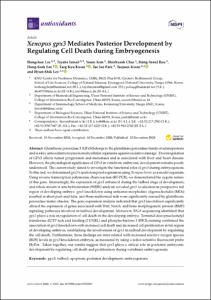Xenopus gpx3 Mediates Posterior Development by Regulating Cell Death during Embryogenesis
- Keimyung Author(s)
- Kwon, Taeg Kyu
- Department
- Dept. of Immunology (면역학)
- Journal Title
- Antioxidants (Basel)
- Issued Date
- 2020
- Volume
- 9
- Issue
- 12
- Keyword
- gpx3; tailbud; apoptosis; posterior development; embryogenesis
- Abstract
- Glutathione peroxidase 3 (GPx3) belongs to the glutathione peroxidase family of selenoproteins and is a key antioxidant enzyme in multicellular organisms against oxidative damage. Downregulation of GPx3 affects tumor progression and metastasis and is associated with liver and heart disease. However, the physiological significance of GPx3 in vertebrate embryonic development remains poorly understood. The current study aimed to investigate the functional roles of gpx3 during embryogenesis. To this end, we determined gpx3's spatiotemporal expression using Xenopus laevis as a model organism. Using reverse transcription polymerase chain reaction (RT-PCR), we demonstrated the zygotic nature of this gene. Interestingly, the expression of gpx3 enhanced during the tailbud stage of development, and whole mount in situ hybridization (WISH) analysis revealed gpx3 localization in prospective tail region of developing embryo. gpx3 knockdown using antisense morpholino oligonucleotides (MOs) resulted in short post-anal tails, and these malformed tails were significantly rescued by glutathione peroxidase mimic ebselen. The gene expression analysis indicated that gpx3 knockdown significantly altered the expression of genes associated with Wnt, Notch, and bone morphogenetic protein (BMP) signaling pathways involved in tailbud development. Moreover, RNA sequencing identified that gpx3 plays a role in regulation of cell death in the developing embryo. Terminal deoxynucleotidyl transferase dUTP nick end labeling (TUNEL) and phospho-histone 3 (PH3) staining confirmed the association of gpx3 knockdown with increased cell death and decreased cell proliferation in tail region of developing embryos, establishing the involvement of gpx3 in tailbud development by regulating the cell death. Furthermore, these findings are inter-related with increased reactive oxygen species (ROS) levels in gpx3 knockdown embryos, as measured by using a redox-sensitive fluorescent probe HyPer. Taken together, our results suggest that gpx3 plays a critical role in posterior embryonic development by regulating cell death and proliferation during vertebrate embryogenesis.
- Keimyung Author(s)(Kor)
- 권택규
- Publisher
- School of Medicine (의과대학)
- Citation
- Hongchan Lee et al. (2020). Xenopus gpx3 Mediates Posterior Development by Regulating Cell Death during Embryogenesis. Antioxidants (Basel), 9(12), 1265. doi: 10.3390/antiox9121265
- Type
- Article
- ISSN
- 2076-3921
- Source
- https://www.mdpi.com/2076-3921/9/12/1265
- Appears in Collections:
- 1. School of Medicine (의과대학) > Dept. of Immunology (면역학)
- 파일 목록
-
-
Download
 oak-2020-0728.pdf
기타 데이터 / 3.1 MB / Adobe PDF
oak-2020-0728.pdf
기타 데이터 / 3.1 MB / Adobe PDF
-
Items in Repository are protected by copyright, with all rights reserved, unless otherwise indicated.